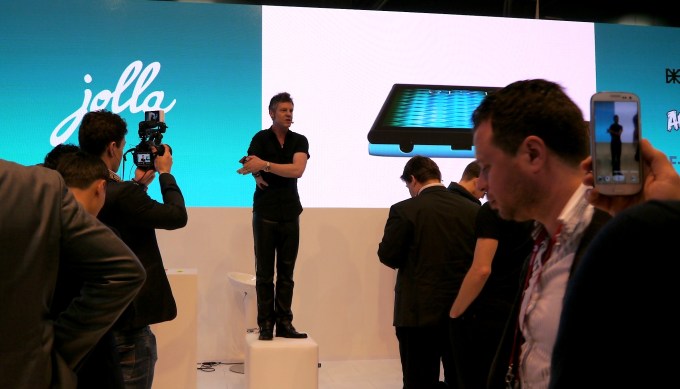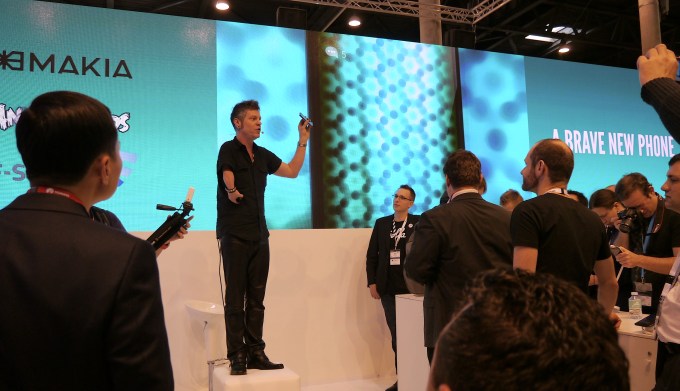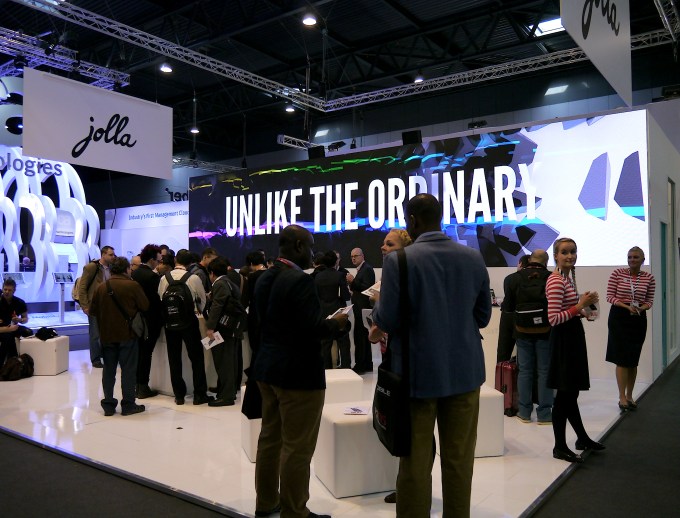“It’s not every day that a new mobile operating system is born,” says Jolla’s Marc Dillon preaching to a congregation of the curious from atop a stool at Jolla‘s booth at the 2014 Mobile World Congress. This is the world’s largest mobile industry gathering. The show which annually transforms Barcelona into a city of suits and queues and shiny things.
It’s a soapbox sales pitch from the new kid on mobile’s block. And it looks really good. The Jolla booth is sizeable, sited in MWC’s first (if not its main) hall, and buzzing with interested visitors when I drop by.
Dillon tells TechCrunch he’s getting up on this public soapbox once a day to introduce the Sailfish mobile OS to potential owners and partners. But this is just the tip of the iceberg. Behind the scenes this fledgling smartphone and OS maker is taking a lot of meetings.
“All of our schedules are full for this week — and a lot of them came to us,” Dillon tells me, now sitting on a stool to talk to TechCrunch. “We didn’t go out seeking partners to have meetings with, they came to us.”
“There’s been everything from OEMs and carriers and ODMs and other kinds of technology. There’s been a huge amount of developer interest here on the stand, people from all different kinds of genres of applications and deep, even low-level, developers and things closer to the hardware,” he continues.
“The innovation is interesting. The things that we didn’t deliver at the beginning that people just do anyway. Like, we didn’t deliver a wi-fi hotspot in the beginning — and somebody just went and created one and now we’re integrating it into the platform.
“These guys over here did an Other Half that has sensors and an RGB display that changes colour depending on things and you can answer the phone by waving your hand over it, and mute it by waving your hand over it. People are just doing this because they want to, and because they believe in what we’re doing.”
OEMs have gotten really squeezed now because [Android] is exactly the same user experience so all they can do is price-point or luxury
Last year Dillon walked out onto MWC’s keynote stage with a similar Sailfish sales pitch for the carrier community and beyond. The difference was then he had to talk about what Jolla intended to do, not what it’s done. A small anonymous cubicle, way off the beaten track and reserved for press and partner meetings, was its only physical presence at MWC 2013 — about as far as you could get from the bright lights and conference hoards.
Inside this featureless cube, only a handful of Jolla-branded stickers and Dillon’s determination stood out from the beige environs.
A year on, Jolla’s brilliantly lit booth is shouting loudly about what this startup has achieved in the past twelve months: its first phone on sale, currently retailing via Jolla’s website in multiple European markets, and also Finnish carrier DNA in its home market, with expansion to India, Russia and Hong Kong on the horizon.
“It’s been really rewarding to know that we’ve done something right,” says Dillon, looking around at the booth bustle. “The most rewarding thing is that people keep coming, and they’re very interested and they keep coming back.”
“Two years ago we were three guys on the floor here, and then last year you saw where we were, and then this is amazing. I’m really pleased with the change,” he adds.
Sales of Jolla’s first phone are “steady”, according to Dillon — but it’s looking to scale its business through a variety of partnership and expansion strategies. Jolla has always intended multiple business models; selling its own hardware is just one of them.
“The key to us for scalability is different kinds of partners, so we’re talking to operators constantly,” he says. “They’re coming to us. I’m expecting some great thing there. We’re also doing things with brands and other things that give us additional reach. But we’re definitely going to be in shops this year. Lots of operators.”
“The OEMs have gotten really squeezed now because [on Android] it’s exactly the same user experience so all they can do is price-point or luxury — adding more cores and shiny things or pushing the price down,” he adds. “We’re trying to provide a high end experience that is scalable to low end devices and high end devices and different form factors.”

On the ‘other brands’ front, Jolla has signed up two fellow Finns, Rovio and Makia, to its Other Half smart covers program — which lets companies augment Jolla handsets with their own content by creating branded backplates that also load unique content onto the inside of the phone.
Rovio’s Angry Birds Other Half collaboration will see a social network-style feed loaded onto users’ handsets — a place for the company to connect with its fans and tease them about new stuff, says Dillon. Meanwhile Makia, a Finnish clothing brand, will get a catalogue on the handset where Jolla owners can browse and buy new threads.
Both Other Half software additions will sit just a single swipe away from the Jolla phone homescreen. The two smart covers aren’t quite ready for the prime-time yet — with content still in development — but are due for release in the first half of this year.
“There’s no other manufacturer in the world that is going to let you rebrand their device and sell it along with it,” says Dillon, showing TechCrunch a glimpse of this work in progress.
“We provide an interface so that a company can come and work within our software, a bit beyond the SDK, so that they can actually make sure they are staying on top of new releases and using the new features as they come out, instead of after they come out.
“And we also have an opportunity for, not only the open community to help prioritise things, but also for our partners — to make sure they get the enablers for the platform so that they can build their business models.”
There’s a hundred million at least potential, and even a few percent of that is already a tremendous thing for a company like us
Another, potentially much more significant expansion strategy for Jolla is that it’s planning to release its Sailfish OS as a free download — to let Android users reflash other OEMs’ devices with its software. Again, this will happen in the first half of this year, with support for a few select devices coming initially, before access gets opened up more broadly.
This a strategy to drive the volume of Sailfish users — and thus ultimately to attract more developers to underpin and nurture the Sailfish ecosystem.
“One of the keys to application developers is volume,” says Dillon. “So this [Sailfish download initiative] is one thing that’s going to entice a lot of developers to come on board — the fact that the volume is going to grow.
“This Sailfish initiative is going to be my focus this year — to make sure that Sailfish is available to get into as many people’s hands as possible.”
An Android launcher is also coming to give people a taster of Sailfish, ahead of any full reflash. “That’s kind of a springboard for us, to be able to show more people what our capabilities are and to give them an opportunity to try the gestures, and to understand there’s a bit of a learning curve,” says Dillon.
How large an opportunity does Jolla see for Android owners to fully reflash their devices with Sailfish? “[Reflashing] is exceptionally common in China, just as one example,” says Dillon, pointing to Xiaomi’s journey from ROM maker to fully fledged smartphone maker as an example of the appetite mobile users can have for change.
“So we’re looking at — there’s a hundred million at least potential, and even a few percent of that is already a tremendous thing for a company like us,” he adds.
Talking of China, that country was an early focus for Jolla — with a 2012 distribution deal signed with Chinese retailer D.Phone being one of its earliest wins. However, since then, things have gone a little quiet on the eastern front, with no concrete launches as yet (although Hong Kong is now apparently imminent).
“We’re still working a lot in China,” says Dillon when asked about goings on in the market. “I don’t have any specifics there but… we have a lot of people that are going there constantly.”
Why the delay with launching into that market? “A lot of it has to do with there are so many different opportunities, making sure that we understand what the best ones are has been more difficult maybe than we expected,” says Dillon, after a moment collecting his thoughts.
“There’s a constant stream of change that goes through China, so making sure that we do the right things, with the right partners there is what we’re spending the time on.”

Where did Dillon hope to be at this point when Jolla started out on its journey? (Lest you forget, the origins of Sailfish and Jolla were a handful of MeeGo engineers leaving Nokia to carry on building the platform that it was abandoning in favour of Windows Phone. So it’s more than a little ironic that Nokia has just forked Android to built a new combination skin atop it.)
“It’s a really interesting, for me, combination of confidence that we’re going to make it, but there’s a huge amount of things that are going on all of the time — there’s managing tens of thousands of pieces of work it takes in order to do this, and dealing with a huge amount of partners. And there’s so many variables — but I couldn’t have imagined it would be like this,” says Dillion, evidently struggling to square the circle of being a small force thinking big.
“That we would actually have such a big beautiful presence [at MWC] with a really beautiful device that is getting better all the time. Our fourth software update is really amazing, I’m really proud of it. I always believed that we were going to do it but it completely overwhelmed my expectations with what we actually achieved. I always knew we were going to get the device out, and for half a year I said there’s nothing we can do to stop it, and then all of a sudden it’s way bigger than what I expected.”
We wanted to create something that was enabling other business not blocking other business
The fourth Sailfish update (coming this month) will bring a raft of updates to the platform — nearly doubling the number of features in the camera software, and also bringing general general performance improvements (including to the Android app runtime); along with core stuff like support for landscape orientation of text-based content.
Notably, the fourth update will also include usability tweaks — in the form of extra signposts — designed to help Sailfish users understand the gestures required to navigate around the UI. Dillon said this is a result of Jolla listening to feedback from early adopters and reviewers.
As I noted in my review of Jolla’s device last month, Sailfish’s gesture-heavy navigation can be confusing for newcomers, especially those accustomed to icons and buttons — which is pretty much all smartphone users now. So it’s great to see Jolla building in a little more hand-holding to help bridge the usability gap between established mobile methodology and brave new world order.
“We made a lot of improvements in the latest software,” says Dillon. “We took a lot of feedback there. Not only did we make it a lot more consistent but also we provide clues to the new user so they can have more understanding.
“One example is people always swipe down — and for us that’s close, so we put a lock from the homescreen to let them know they’re closing the device. Or locking it, if they have lock enabled. And when you have an application open it very prominently tells you you’re closing the application [by displaying a large cross icon over it] — because that was one thing people were getting confused about.”
“It still boils down to left right, up and down. And left and right are basically the same most of the time, and scrolling everybody already knows… but we’ve taken it really seriously and we’ve done a lot of work on it,” he adds.
“We went through every single application to make sure they work in a consistent manner and we’re adding little clues all over the place to make sure that a new user gets a better experience. We also found a lot of people who were trying the device or reviewing the device weren’t going through the tutorial. So we’ve made a lot of improvements there, and we’re trying to encourage users to go through the basics a little bit.”
As well as taking feedback, Jolla is also open to — and openly listening out for — ideas for future features from its community of users.
“There’ve been a lot of ideas about things to do with the Other Half — like glowing different colours… so instead of just having different colours, what if it’s just clear and it changes colour all of the time, or it gives you some information,” says Dillon when asked what sorts of ideas the community is coming up with.
Such cool sounding hardware add-ons for Jolla handsets are likely to have to be built by other startups (or brands) at this point, though, rather than by Jolla itself — being as its core focus is, as it has to be, on spreading the Sailfish platform as far and wide as it can.
There are plenty of sobering examples of failed or faltering mobile platforms to illustrate how ecosystems really need developers to survive, and developers go where the volumes are. And/or where the money is.
Hence Jolla’s focus on trying to scale Sailfish with all the help from others it can get (it is also drawing on the Android ecosystem, via app compatibility, rather than trying to shut it out entirely). That’s why it’s designed its hardware, software and business models to be extensible by others. Even its hardware Other Half is a platform with an SDK.
“That’s the point,” says Dillon. “We wanted to create something that was enabling other business not blocking other business… The priorities that we have at the moment [are] Sailfish and creating partnerships. What’s most important to me now is that we continue to build a user base, continue to build partnerships and enablers for those.”
So where, then, does Dillon want Jolla to be this time next year — at MWC 2015? “I think next year we’re going to have a lot of different partners on the stand, we are going to have our devices in a lot of other companies’ booths, and I believe that we are going to have a lot more good stories to tell,” he says.
“I would like to see some operators, carriers, and brand houses being able to use Sailfish as a platform to help their business, and also to work with our business.”
And with that, Dillon is off again — to mingle with the people who are busy getting to know Sailfish. And to keep on thinking bigger.

